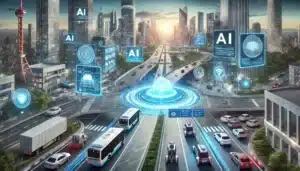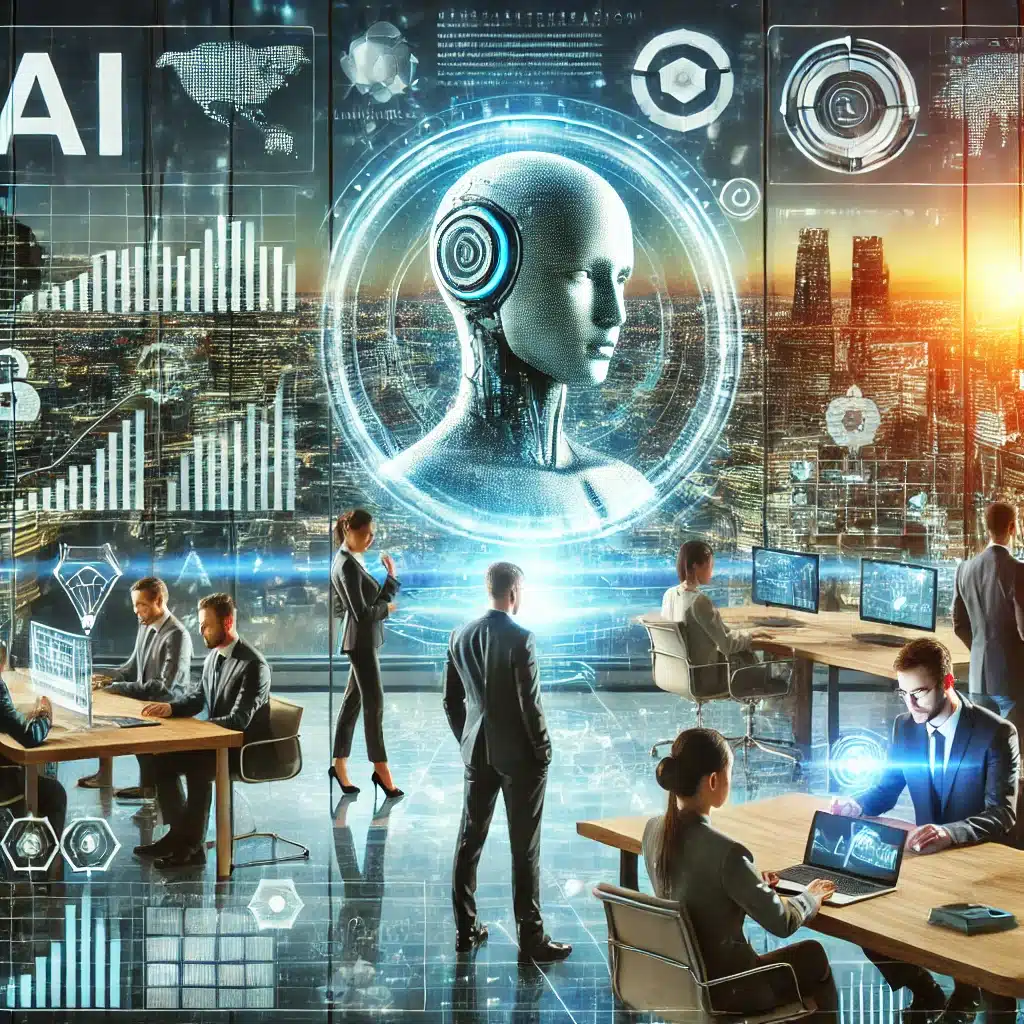The transportation industry is undergoing a significant transformation thanks to the integration of artificial intelligence (AI) technologies. AI in transportation is not just about improving logistics; it encompasses a wide range of applications that enhance safety, optimize traffic management, and revolutionize public transport services. As we delve into the key use cases of AI in the transportation sector, we will explore how machine learning and real-time data analytics are shaping the future of transport.
What Are the Key Use Cases of AI in Transportation Industry?
How is AI Optimizing Logistics in the Transportation Sector?
In the logistics and transportation industries, AI is playing an increasingly important role in streamlining supply chain functions. Logistics organizations are increasingly implementing AI algorithms to automate their operations, improve fleet management, and optimize inventory management. With AI, these organizations can process large volumes of data to make effective decisions that minimize costs and maximize efficiency. AI systems, for instance, can predict demand fluctuations, enabling logistics companies to adjust their strategies accordingly. Through predictive capacity, resource planning results improve, making the supply chain more responsive. AI also aids in routing optimization, meaning that fleets have improved navigation during traffic jams and are waiting less, resulting in efficient service delivery.

What Are the Benefits of AI in Traffic Management?
AI in traffic management provides a multitude of benefits that significantly enhance urban mobility. By utilizing real-time data analytics, city planners can implement AI-powered solutions that monitor and manage traffic flow more efficiently. These AI applications can analyze traffic data from various sources, such as sensors and cameras, to predict congestion and implement strategies to mitigate it. For example, AI algorithms can adjust traffic signals dynamically based on real-time traffic conditions, reducing delays and enhancing overall traffic flow. Furthermore, the integration of AI in traffic management systems allows for better coordination between different modes of transportation, which is essential for creating a seamless urban transit experience.
How Does AI Enhance Public Transport Services?
Public transport services are benefiting immensely from AI technologies. AI helps enhance operational efficiency by optimizing routes and schedules based on real-time demand. For instance, transit agencies can use AI analytics to understand peak travel times and adjust their services accordingly, ensuring that buses and trains run more frequently during high-demand periods. Additionally, AI applications are being utilized to improve the customer experience. Passengers can receive real-time updates on vehicle arrivals and delays through AI-powered apps, allowing them to plan their journeys more effectively. This not only increases customer satisfaction but also encourages more people to use public transport, contributing to reduced traffic congestion and a lower carbon footprint.
How is Machine Learning Transforming the Transportation Industry?
What Role Does Machine Learning Play in Traffic Flow Optimization?
Machine learning is a subset of AI that is particularly influential in optimizing traffic flow. By training algorithms on historical traffic data, machine learning models can predict traffic patterns and identify potential bottlenecks. This predictive capability allows transportation authorities to implement proactive measures to alleviate congestion before it occurs. For example, machine learning can be used to develop advanced traffic signal control systems that adapt to changing traffic conditions in real-time. These systems not only enhance the flow of vehicles but also improve safety by minimizing the risk of accidents in congested areas.
How Can Machine Learning Improve Travel Time Predictions?
Accurate travel time predictions are crucial for efficient planning in the transportation industry. Machine learning algorithms can analyze historical and real-time traffic data to provide precise estimates of travel times across various routes. By incorporating factors such as weather conditions, road work, and traffic accidents, these AI systems enhance the reliability of travel time estimates. This improved accuracy helps drivers make informed decisions about their routes, reducing frustration and enhancing the overall travel experience. Furthermore, logistics companies can leverage these insights to optimize delivery schedules, ensuring that goods arrive on time.
What Are Some Real-World Applications of Machine Learning in Transportation?
Real-world applications of machine learning in transportation are diverse and impactful. For instance, ride-sharing companies utilize machine learning models to match drivers with passengers efficiently, minimizing wait times and optimizing routes. Similarly, freight companies employ machine learning to predict shipment delays and optimize delivery routes based on real-time data. Additionally, autonomous vehicles heavily rely on machine learning to interpret sensor data and make real-time driving decisions. This technology is at the forefront of transforming the transportation sector, paving the way for safer and more efficient travel.
What is the Future of AI and Autonomous Vehicles in Transportation?
What Advances Are Being Made in Self-Driving Car Technology?
The future of AI in transportation is closely linked to the development of autonomous vehicles. Significant advances are being made in self-driving car technology, driven by AI algorithms that enable vehicles to navigate complex environments safely. Companies are investing heavily in research and development to improve the sensors and machine learning models that power these vehicles. Innovations such as computer vision, which allows cars to interpret visual data from their surroundings, are critical for the safe operation of self-driving cars. As these technologies mature, the prospect of fully autonomous vehicles becoming a common sight on our roads is increasingly realistic.
How Will Autonomous Vehicles Impact Traffic Conditions?
The widespread adoption of autonomous vehicles has the potential to drastically alter traffic conditions. Self-driving cars are designed to communicate with each other and the surrounding infrastructure, which could lead to smoother traffic flow and reduced congestion. By optimizing driving patterns and minimizing human error, autonomous vehicles can help decrease the frequency of accidents, which often contribute to traffic jams. Moreover, the integration of AI technologies in autonomous vehicles can lead to more efficient routing, further alleviating traffic congestion. The future of transport could see a significant reduction in travel times and improved overall road safety.
What Are the Challenges Facing AI Development in Self-Driving Technologies?
Despite the promising future of AI in transportation, several challenges must be addressed to realize the full potential of self-driving technologies. One major hurdle is the development of robust AI solutions that can handle the complexities of real-world driving scenarios. Variability in weather conditions, unpredictable human behavior, and the need for sophisticated decision-making in split-second situations pose significant challenges for AI systems. Additionally, regulatory and ethical considerations surrounding autonomous vehicles must be navigated carefully to ensure public safety and acceptance. The path to widespread adoption of self-driving cars will require collaboration between technology developers, policymakers, and the community.
How Does AI Integration Improve Safety in Transportation?
What AI Solutions Are Used for Enhancing Road Safety?
AI enhances road safety through various innovative solutions. For instance, manufacturers are integrating AI-powered safety systems into vehicles to help drivers avoid accidents. These systems use real-time sensor data to detect potential hazards, such as pedestrians or other vehicles, and issue alerts or take corrective actions when necessary. Additionally, analysts use AI to examine accident data, identify patterns, and develop risk-mitigation strategies. By leveraging machine learning algorithms, transportation authorities implement targeted safety measures in high-risk areas, ultimately reducing accidents.
How Does Real-Time Data Analytics Contribute to Safer Travel?
Real-time data analytics is a crucial component of transportation safety initiatives. By collecting and analyzing data from various sources, including traffic cameras and GPS systems, AI can provide valuable insights into current road conditions and potential hazards. This real-time information allows transportation agencies to respond quickly to emerging safety concerns, such as accidents or road obstructions. Additionally, real-time data can be used to inform drivers of hazardous conditions ahead, enabling them to make safer travel decisions. The integration of AI in data analytics not only enhances safety but also promotes a culture of proactive risk management within the transportation sector.
What Are the Benefits of AI-Powered Safety Systems in Vehicles?
The benefits of AI-powered safety systems in vehicles are manifold. These systems enhance overall vehicle performance by integrating advanced technologies that assist drivers in making safer decisions. For instance, features such as adaptive cruise control and lane-keeping assistance rely on AI algorithms to monitor driving conditions and provide real-time feedback. Such innovations not only protect drivers and passengers but also contribute to safer roads for all users. As AI technologies continue to evolve, the potential for these systems to prevent accidents and save lives will only increase, making them an essential aspect of modern vehicle design.
What Is the Role of AI in Traffic Data Management?
How Can AI Analyze Traffic Data to Reduce Congestion?
AI’s ability to analyze traffic data plays a vital role in reducing congestion in urban environments. By processing large datasets from various sources, AI can identify patterns and trends in traffic behavior, enabling transportation authorities to implement more effective management strategies. For instance, AI systems can analyze historical traffic data to predict peak congestion times and offer route alternatives or adjust traffic light timings accordingly. This proactive approach not only alleviates congestion but also enhances the overall efficiency of transportation networks, making urban mobility more sustainable.
What Are the Applications of AI in Real-Time Traffic Monitoring?
Real-time traffic monitoring is one of the most impactful applications of AI in the transportation sector. AI-powered systems can continuously assess traffic conditions using data from cameras, sensors, and mobile devices, providing live updates on congestion levels, travel speeds, and incidents. This information is invaluable for drivers, who can make informed decisions about their routes based on current conditions. Additionally, transportation agencies can use this real-time data to deploy resources effectively, respond to incidents promptly, and manage traffic flow more efficiently. The integration of AI in real-time traffic monitoring systems significantly enhances the operational capabilities of transportation authorities.
How Does AI Help in Predicting Traffic Conditions and Wait Times?
AI’s predictive capabilities are instrumental in forecasting traffic conditions and wait times. By analyzing historical data and real-time inputs, AI systems can generate accurate predictions about traffic patterns and potential delays. These insights are crucial for both commuters and logistics companies, allowing them to plan their journeys more effectively. For instance, AI-powered navigation apps can provide users with estimated arrival times based on current traffic conditions, enabling them to avoid congested routes. Moreover, logistics companies can leverage these predictions to optimize delivery schedules, ensuring timely arrivals and improving customer satisfaction.
Conclusion
AI is undoubtedly transforming the transport sector, ranging from streamlining logistics and enhancing traffic management to better public transport systems and the potential for autonomous vehicles. With advancing AI technologies, we can look forward to intelligent, safer, and more efficient transport systems that minimize congestion, improve road safety, and make a more sustainable future. The adoption of AI-led innovations will be instrumental in realizing the full potential of contemporary transportation to the advantage of businesses, travelers, and urban planners.



